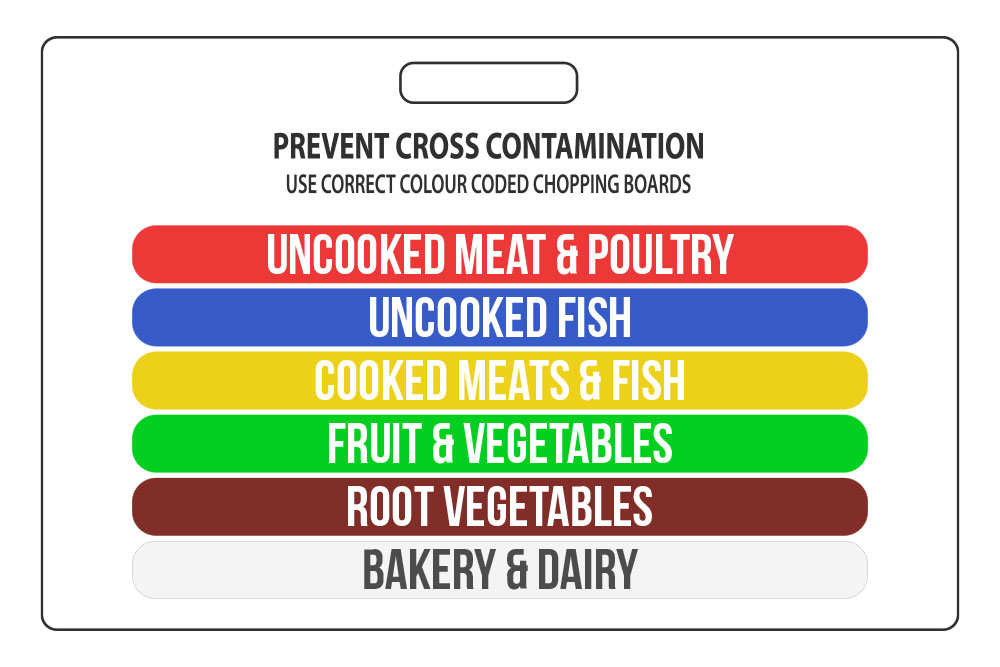
Most UK people trust food manufacturers and restaurants to meet food safety standards.
Faith in takeaways is also generally high, although not quite to the level of sit-in establishments.
But maintaining these confidence levels takes work. One of the fundamentals is using different chopping board colours to ensure low and high-risk foods don’t mix.
You need to know what goes where in the kitchen, from fish to free-from or roasted meat to root vegetables.
Read our guide to learn the different chopping board colours and how to use them to prevent foodborne contamination when cooking.
Why Are Different Chopping Boards Needed?
Cross-contamination between foods is one of the leading causes of foodborne illness. It happens when harmful bacteria from one foodstuff is transferred to another through tools, utensils, hands or work surfaces.
That’s why colour-coded chopping boards are essential in any kitchen. They let chefs prepare low and high-risk foods without the risk of cross-contamination. Plus, in a professional kitchen where speed is critical, the colours let chefs instantly recognise where they can (or can’t) prepare certain foods.
You can extend the colour system to other essential utensils like knives for extra protection.
Types of Chopping Boards
Colours aren’t the only thing that chefs consider when choosing the right chopping board for the task at hand. The material the chopping board is made from also plays a factor, with plastic and wood being the two main options.
Most people would opt for a plastic chopping board when preparing high-risk foods such as raw meats, believing it to be more hygienic.
However, experts are split on the truth of the matter.
Some believe plastic boards are more hygienic because they’re non-porous and easier to clean properly.

Others claim wooden boards are more hygienic due to their natural ability to absorb and smother microbes, preventing them from reproducing.
Really, it’s up to you to decide which type of chopping board you like to use for different tasks. As long as you maintain it in good order and use the colour system.
Chopping Board Colours
No legislation requires kitchens to use colour-coded chopping boards. But it’s a widely accepted practice because it’s a simple way to minimise the risk of cross-contamination.
You must know your chopping board colours to improve your kitchen’s hygiene. The colours have a logic, which you’ll understand as you learn what each board is for.
Red – Uncooked Meats
Red chopping boards are for raw meat and poultry. As one of the most likely sources of foodborne illness, these boards must be well maintained and used only for uncooked meats.
Yellow – Cooked Meats and Fish
Yellow chopping boards are exclusively for cooked meat and fish. You mustn’t ever use them to prepare raw animal products to keep food safety standards at an acceptable level.
White – Dairy and Baked Goods
White chopping boards have dual use and are used for dairy and bakery items. This makes them suitable for everything from cutting cake to grating cheese.
But be mindful of potential allergens. Dairy is typical, so washing the board between uses is essential. You can also have two dedicated chopping boards (one for dairy and one for baked items), but this might not be very clear for you or your team. For safety’s sake, it might be best to only use a white chopping board for foodstuff that is not an allergen.
Blue – Uncooked Fish
Blue chopping boards are for uncooked fish. As another high-risk food, you must only use your blue board for raw seafood. You must also put extra effort into cleaning them regularly and keeping them in good condition.
Brown – Root Vegetables
Brown chopping boards are where you should be preparing any uncooked root vegetables. These foodstuffs will often have traces of soil left on them, which means they’re likely to spread microbes. Keep them isolated on brown chopping boards only.
Purple – Free-From Foods
Purple boards are for ‘free-from’ foods – products and items specifically for allergy sufferers or those with food intolerance. Using a board exclusively for these foodstuffs prevents cross-contamination of allergens, not harmful microbes.
And since allergens are as risky for certain people as microbes are for others, it’s good practice to use purple boards correctly in your kitchen.
A prominently displayed poster in the kitchen helps to remind staff to use the correct colour chopping board during food preparation.
When to Replace Your Chopping Board
Other than colours, the most important thing you need to consider is the condition of the chopping board when preparing food.

You should replace any chopping board if:
- It has deep scratches or scores – deep scratches are impossible to clean thoroughly and give microbes a safe haven to live and reproduce; this is particularly problematic for plastic boards
- It can’t lay flat on a surface – heavily used chopping boards gradually lose shape and will eventually warp, making it unsafe to chop food on
How You Can Increase Food Safety Standards
Most professional kitchens use high-quality colour-coded chopping boards to keep food safety standards high. But it’s not the only investment you can make to keep your kitchen hygienic.
Our online Food Safety Training is essential for anyone who prepares, handles or serves food. The course teaches food safety fundamentals, including crucial measures to raise hygiene standards and how to spot and improve areas where problems may develop. With this awareness, you can keep your kitchen hygienic, maintain customer confidence and support compliance with food safety legislation.




























































































































































































































































































































































































































































































































































































































































































































































